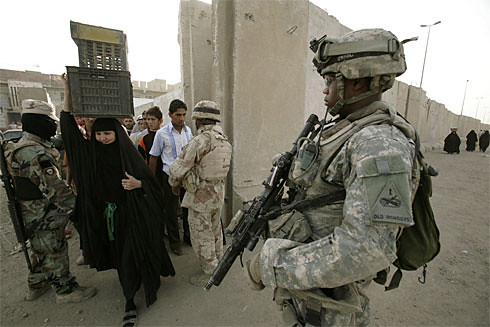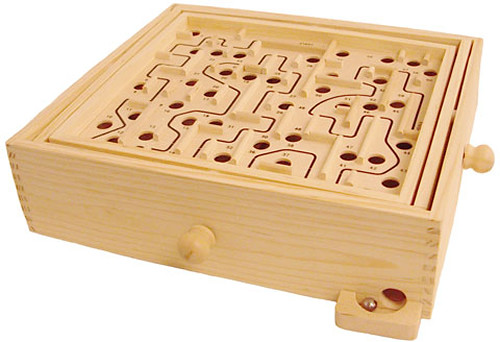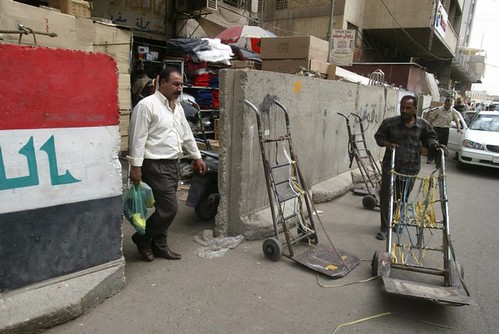Baghdad's Teetering Floors

[Image: A U.S. Army soldier secures a checkpoint at the wall that separates southern Sadr City from the north, in Baghdad / AP photo, Baghdad's walls keep peace but feel like prison, 2008.]
If anyone knows where to find a complete map – or, as complete as possible – of all the security walls and separation barriers that have been (and are) being devised within Baghdad by American forces, I’d love to see it. I have found a few maps of some separate districts, but it seems like there must be a project out there tracking this more comprehensively.
Anyway, I say this because a recent article for USA Today reports on another wall that began construction just a couple of weeks ago around the neighborhood of Hurriyah. “The new wall ties into two existing walls to prevent Shiite extremists from coming and going at will — and presumably from smuggling in arms,” we are told.
Just a few days after construction was underway, however, a truck bomb exploded killing 68 people there. So, again, I scratch my head, and ask – do the walls prevent violence, or just seem to trigger it?

[Image: The Baghdad Table, by Edra Tarazi.]
In addition to the 3-mile-long wall in Azamiyah, a wall in Amariyah, and the new one in Sadr City, the article mentions the district of Doura, which apparently “has so many walls and observation towers that some parts resemble a maze.”
Nowadays there's hardly a street in Baghdad without a wall — or a cheaper substitute like barbed wire, palm tree trunks, mounds of dirt or piles of rocks. They're even used to control pedestrian and vehicular traffic in risky areas. – USA TodayThere isn’t much else in the article you probably don’t already know, for instance how the walls “block access to schools, mosques, churches, hotels, homes, markets and even entire neighborhoods — almost anything that could be attacked,” the reporter suggests. They “also lead to gridlock, rising prices for food and homes, and complaints about living in what feels like a prison.”
NPR covered the devastating challenges the barriers pose for local economies last week.

[Image: Labyrinth, the game.]
Baghdad is starting to remind me a lot of that old wooden board game Labyrinth, I think it was called, or, maybe it was Tilt-A-World. The one you angled two wooden platforms back and forth with rotating knobs to maneuver a little steel marble through a maze of walls without dropping it into a hole. Ultimately, it was a game of delicate touch, floor balance, and tactical wall hugging. Advancing the marble required a strategy of resting it in a sequence of corners, or hold-outs, until you were ready to carefully slope the board again and make a run rolling the it along a fragmented edge hoping to reach another little bunker to pause once more.
It was a labyrinth of baby steps and well timed wall crawls, and playing it was a test of nerves since it took a steady hand to ever so gently pitch the platforms together in a combined direction that would roll the marble precisely where you wanted it to go. I imagine it like trying to diffuse an IED with your bare hands. One faulty overturn or misadjustment, and you were dead.

But, it’s almost as if Baghdad has been turned into a mortal-sized version of this game since everyone and everything in the city now moves according to a system of blast walls, security barricades, revolving iron gates, military checkpoints, bunkers, IEDs, car bombs, etc. Perhaps, in this case, the American and Iraqi forces have their hands on one of the dials, while the sectarian militia groups collectively have their hands on the other. Wrestling for control of the city, Baghdad is in a constant state of imbalance and instability, subject to ceaseless shifts of power, while its civilians teeter on the edges of sudden death much like the innocent steel marble whose slippery fate rests in the hands of the war lords.
But, don't you think it will take more than the weight of all these walls to bring balance to Baghdad's teetering floors?
(Thanks to Mike for the link!)







1 Comments:
As it turns out, I'm looking for just the same thing - i.e. comprehensive documentation of what has been built and planned for these "security" walls. I will keep you posted as to whether anything turns up on my end and I look forward to your continued thoughts and reflections on the ongoing walling of the city.
My thesis deals in large part with this very topic so it would be great for us to connect in the near future. I'm based in Berkeley.
Cheers, Mona
Post a Comment
<< Home